What is The Best Hot Tub For Cold Climates
Discover the top hot tubs for cold climates, featuring powerful heaters, energy-efficient designs, and durable construction for year-round use.
The best hot tub for cold climates is one that is well-insulated and has powerful heating capabilities
If you’ve ever dreamed of sinking into steaming water while snow drifts outside, you’re not alone, but picking the best hot tub for cold climates is trickier than it seems. Many tubs lose heat fast, driving up your power bills and leaving you shivering instead of soaking.
The good news? Modern hot tubs now come with advanced insulation, energy-smart tech, and clever designs built to thrive in sub-zero temperatures. In this guide, you’ll learn:
- Smart tips to boost warmth and cut energy bills
- Which brands and features truly stand up to harsh winters
- Costs you can expect for cold-weather models
- 14 Tips for Best Hot Tub Use in Cold Climates
- Things to Consider When Buying:
- 6 Key Features To Look For in a Cold-Weather Hot Tub
- Check out our cold-weather hot tubs!
- Best Plug-and-Play Hot Tubs for Cold Climates
- Best Inflatable Hot Tubs for Cold Weather
- Comparing Hot Tub Insulation Types
- HOW TO CHOOSE THE BEST HOT TUB FOR COLD CLIMATES
- Types of Hot Tubs for Cold Climates
- STAY WARM ALL WINTER LONG
- How to Prepare and Maintain Your Hot Tub for Winter
- Energy Costs and Savings in Cold Climates
- Why Cold Climates Demand Special Hot Tubs
- User Reviews & Real-World Experiences
- FAQs
14 Tips for Best Hot Tub Use in Cold Climates
- Use a High-Quality Cover – Keeps heat in and snow out.
- Maintain Water Level – Prevents pumps from running dry and freezing.
- Set a Steady Temp – Avoid big drops that strain your heater.
- Run the Pump Often – Circulates warm water to stop freezing.
- Check for Leaks – Even small drips can freeze and cause damage.
- Use a Thermal Blanket – Adds insulation and cuts heat loss.
- Block Wind – Use screens or fences to shield your tub.
- Keep Snow Off the Cover – Heavy snow can warp or crack it.
- Clean Filters Regularly – Helps your system run efficiently.
- Install Freeze Protection Sensors – Auto-activate heat when temps drop.
- Watch Power Outages – Restore power quickly to avoid freezing pipes.
- Lower Water Temp Slightly When Away – Saves energy but keeps water from freezing.
- Step Carefully – Decks and steps get icy fast in winter.
- Soak Smart – Limit soak time to avoid big heat loss when it’s freezing outside.
Things to Consider When Buying:
- Insulation: A well-insulated hot tub will retain heat better, saving you money on energy costs. Look for a hot tub with thick insulation, preferably at least 2 inches thick.
- Cover: A cover is essential for keeping heat in and cold air out. Make sure to get a cover that is specifically designed for cold weather.
- Heating Element: The heating element should be powerful enough to raise the temperature of the water quickly, even in cold weather.
- Foaming Jets: Foaming jets help to create a layer of bubbles on the surface of the water, which helps to insulate the hot tub and keep the heat in.
- Skimmers: Skimmers help remove debris from the water, which can prevent the hot tub from freezing.
- Location: If possible, place the hot tub in a sheltered location away from the wind.
6 Key Features To Look For in a Cold-Weather Hot Tub
1. Full-Foam vs. Perimeter Insulation
Insulation is your first line of defense. It’s what keeps the warmth in and the cold out. But not all insulation methods are created equal.
- Full-Foam Insulation: Fills the entire cabinet with dense foam, reducing heat loss and supporting plumbing. Ideal for freezing climates.
- Perimeter Insulation: Uses reflective panels and air gaps—cheaper and lighter, but less reliable in extreme cold.
If you’re in a place where winter doesn’t mess around, full-foam is the safer bet. It may cost more upfront, but it’ll save you long-term on heating.
2. High-Quality Covers and Heat Seals
A flimsy cover is like leaving your front door cracked open all winter. Good covers do more than keep leaves out—they trap heat and block cold air.
Look for:
- Tapered, 4″ to 5″ thick covers that shed snow and seal tightly
- Reinforced hinges and locking straps to keep the seal secure
- Insulated heat seals around the edges to prevent warm air from escaping
3. Energy Efficiency Ratings (CEC, Energy Star)
Heating water in winter doesn’t have to break the bank. Look for hot tubs that meet recognized energy standards:
- CEC (California Energy Commission): Tubs with this rating have passed strict energy use tests.
- ENERGY STAR® (limited availability): Not all hot tubs qualify, but those that do are designed to run efficiently year-round.
4. Freeze Protection and Smart Controls
A frozen pump or pipe isn’t just a nuisance—it can destroy your system. That’s why built-in freeze protection is a must.
What helps:
- Freeze sensors that kick on the heater automatically when temps dip
- Circulation pumps that keep water moving and prevent freezing
- Wi-Fi-enabled smart controls so you can monitor and adjust settings even when you’re away
5. Build Materials Suited for Extreme Temps
Winter takes a toll on cheap materials. That glossy-looking tub might look great in a showroom but crack under pressure when the frost sets in.
Look for:
- Acrylic or ABS shells backed with fiberglass for strength and durability
- Pressure-treated synthetic cabinets that resist moisture and won’t warp
- Rust-proof frames, especially if you live somewhere with snow and ice buildup
6. Advanced Jet Systems That Don’t Lose Heat
Jets are great until they act like vents. Poorly designed systems can pull warm water away or introduce cold air into the tub.
Choose tubs with:
- Closed-loop plumbing to reduce heat loss
- Adjustable, insulated jets that prevent cool air intake
- Quiet operation so you’re not hearing a growl every time the pump kicks in
Quiet Pumps and Efficient Heaters
Pumps and heaters are the workhorses of your spa. In winter, they’re running overtime. You want parts that are up for the job—and don’t sound like a snowblower.
Look for:
- Circulation pumps that operate quietly and keep water moving 24/7
- Titanium or stainless steel heaters that heat quickly and resist corrosion
- Variable-speed motors that adjust flow to balance performance and energy use
Check out our cold-weather hot tubs!
1. Sundance Oasis 5-Person Hot Tub:
The Marin Hot Tub is a spacious, luxurious spa for relaxation and comfort. With room for up to five adults, it offers a variety of seating options, including a lounge seat for full-body bliss and a unique hub for intimate conversations.
This 880 Series model is thoughtfully designed for easy access, featuring a low-profile design and illuminated cabinetry for added safety and style.
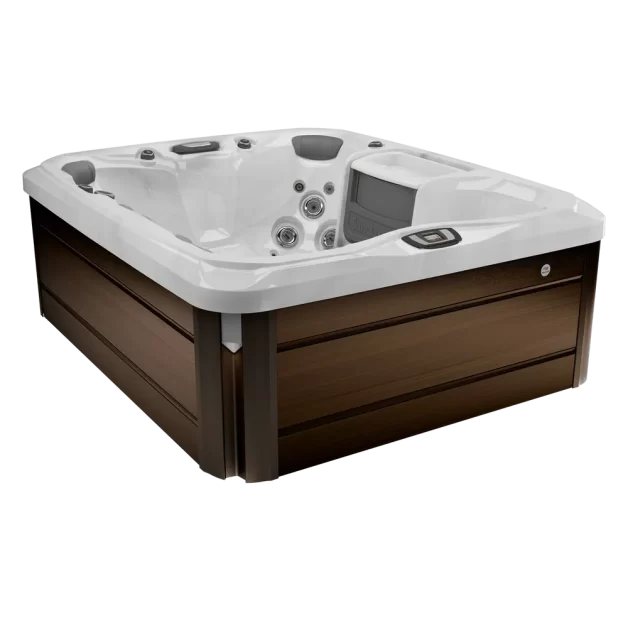
2. Essential Hot Tubs – Shoreline Lounger 24 Jet 6-Person
The Essential Hot Tubs Shoreline Lounger is your perfect relaxation retreat. This spacious 6-person hot tub features 24 stainless steel jets that offer a range of therapeutic experiences, from passive relaxation to deep tissue stimulation. Its comfortable lounger-style seats provide ultimate comfort and relaxation.
Key Features:
- 24 Stainless Steel Jets: Enjoy a variety of therapeutic experiences with the 24 stainless steel jets, including passive therapy, deep tissue stimulation, and invigorating massages.
- Spacious Design: With dimensions of 74.5″L x 74.5″W x 32″H, this hot tub offers ample space for both solo relaxation and group spa sessions, comfortably accommodating up to 6 adults.
- Plug & Play: Easy setup with plug-and-play convenience, and the 1kW (120V 15A) all-season stainless-steel Balboa heater can be converted to 240V (4kW) for increased energy efficiency.
- Cover Included: Comes with a heavy-duty, insulated tapered cover and durable locking clips to keep your hot tub area safe and clean when not in use.
- Made in the USA: Crafted with quality materials and expert craftsmanship at the Pennsylvania manufacturing plant, ensuring a luxury spa experience.
3. Bueno Spa Atlanta 3 Persons 37 Jets Hot Tub
3-Person 37-Jet Hot Tub in Sterling Silver and Gray. This hot tub is designed for optimal relaxation, featuring two reclining lounges positioned next to each other, perfect for couples. The innovative MySeat design eliminates height differences, ensuring comfort for all users. With a manageable 29.5″ height, it can easily fit through a standard front door.
Key Features:
- Dual Reclining Lounges: Two reclining lounges provide exceptional relaxation, making it ideal for couples to unwind together.
- MySeat Design: The MySeat design eliminates height-related inconveniences, ensuring comfort for all users.
- HorizontSide Cabinet: This cabinet is made from a horizontally laid, thick-lath, wood-effect, UV-resistant polymer material unit, adding both durability and aesthetics to the hot tub.
- Color Therapy Lighting: Enhance your psychological well-being with Color Therapy lighting, creating a positive atmosphere for relaxation.
- Superfine Filter & Ozone Generator: This hot tub features a high-quality filter and an ozone generator to ensure crystal-clear, high-quality bathing water.
- Thermal Cover: The included thermal cover ensures consistent water quality and the highest level of thermal insulation effectiveness, optimizing energy efficiency.
Essential Hot Tubs 28-Jet Edgewater
28-Jet Edgewater Hot Tubs is a spacious, high-performance hot tub that can seat up to 5-6 people. The hot tub is constructed from durable acrylic and features a driftwood color that will complement any outdoor setting.
Product Features:
- 28 stainless-steel adjustable jets, allowing you to switch between passive therapy and invigorating massage at the touch of a button.
- Seats 5-6 people with options for lounger or non-lounger seating configurations.
- Plug & play design with a GFCI cord included. No unique electrical connections are needed.
- This is a 1kW/4kW (120V/240V) true all-season stainless-steel Balboa heater, allowing you to use it all year round.
- A heavy-duty, insulated tapered cover with locking clips is included for added protection and energy efficiency.
- Made in the USA and manufactured to the highest standards.
Best Plug-and-Play Hot Tubs for Cold Climates
Plug-and-play hot tubs are easy to set up and run on standard 110V outlets, but they face challenges in freezing temps. Most have smaller heaters and pumps, so heat recovery can be slower, especially after removing the cover.
To work well in cold climates, they need:
- Full-foam insulation
- A thick, well-sealed cover
- Wind protection and thermal blankets
Top Cold-Weather Plug-and-Play Picks
| Model | Insulation | Capacity | Highlight |
|---|---|---|---|
| Lifesmart LS100 | Full-foam | 4 adults | Digital controls, thick cover |
| AquaRest Select 300 | Foam shell | 2–3 | Compact, winter-tested |
| Essential Arbor 20-Jet | Partial foam | 4–5 | All-season rated, roomy |
Limitations
- Slower heating (up to 24 hours to reach 104°F)
- Can’t heat and jet at the same time
- Higher winter energy use if poorly insulated
With the right setup, these tubs can work well in cold weather, just don’t expect full 220V performance. Up next: how inflatable tubs handle the cold.
Best Inflatable Hot Tubs for Cold Weather
Inflatable hot tubs might seem like a bargain, but freezing weather quickly shows their limits. While some newer models include tech to handle chilly temps, you’ll need to put in a bit of extra effort if you want your soak to stay warm when the mercury drops.
Challenges of Inflatable Tubs in Winter
Unlike hard-shell tubs, inflatables use thin, air-filled walls that bleed heat fast. Cold air and snow can sap warmth, making it tough to keep water at a steady 104°F.
Common issues include:
- Slow heat-up times, some units take over 24 hours to reach full temp
- Constant heat loss when the cover’s off
- Limited insulation in the walls and base
- Higher power costs as heaters work overtime
In severe cold (below 40°F), many manufacturers advise against using inflatable tubs altogether.
Brands and Models That Perform Best
Despite the challenges, some inflatable tubs stand out for winter use. They include built-in freeze protection and thicker materials to hold heat longer.
| Model | Freeze Tech | Capacity | Highlight |
|---|---|---|---|
| Bestway SaluSpa Helsinki | Freeze Shield™ | 2–4 | Durable walls, stable at ~40°F |
| Intex PureSpa Plus | Frost Watch | 4 adults | Easy setup, insulated cover |
| Coleman SaluSpa Bahamas | Freeze Shield™ | 2–4 | Budget-friendly, user-tested |
These models can work in cool weather if kept sheltered and heated consistently.
DIY Tips to Keep Inflatable Tubs Warm
If you’re set on using an inflatable tub in winter, a few hacks can help hold in precious heat:
- Place foam insulation boards under the tub to block ground chill.
- Wrap the tub’s exterior with thermal blankets or insulated wraps.
- Use a floating thermal blanket to reduce surface heat loss.
- Build a windbreak around the tub to block icy gusts.
- Keep the cover on tightly whenever you’re not soaking.
Even with these steps, expect higher electric bills, as inflatable tubs are simply less efficient in cold weather.
Comparing Hot Tub Insulation Types
When winter sets in, your hot tub’s insulation decides whether you’ll be floating in comfort—or paying sky-high electric bills. Understanding how different insulation styles work can save you headaches and money down the line.
Full-Foam vs. Thermal Lock vs. Hybrid
Full-Foam Insulation
- Fills the entire cabinet with dense foam
- Minimizes heat loss and adds structural support
- Best choice for harsh winters but can make repairs trickier
Thermal Lock (Perimeter Insulation)
- Lines the cabinet walls with reflective panels, leaving open air around pipes
- Easier to service but less effective in freezing temps
- Costs less upfront but might raise your electric bill in cold weather
Hybrid Systems
- Mixes full-foam around plumbing with reflective panels on the cabinet walls
- Balances energy savings and service access
- Popular in newer mid-to-high-end models
If you live somewhere winter likes to bite, full-foam is the safest bet for heat retention.
Noise Levels
Insulation doesn’t just keep the water hot—it muffles pump and motor sounds, too.
- Full-foam tubs tend to run quieter, since the foam absorbs vibration.
- Thermal lock systems can sound louder because of hollow air spaces acting like echo chambers.
- Hybrid models vary depending on how much foam they use.
So, if you want peaceful soaks without humming in the background, foam-heavy tubs are your friend.
Heat Loss Test Results (Where Available)
Manufacturers don’t always publish heat loss data, but independent tests and user reports offer some clues. In cold-weather trials:
| Insulation Type | Average Heat Loss (°F/hr) | Winter Electric Cost Estimate |
|---|---|---|
| Full-Foam | 1–2°F/hr | $50–$80/month |
| Thermal Lock | 3–5°F/hr | $80–$120/month |
| Hybrid | 2–3°F/hr | $60–$100/month |
Even a small difference in heat loss adds up. Losing an extra 2°F per hour could cost you an extra $20–$40/month in heating bills during peak winter.
For more information, can I put ice in my hot tub? What Can I Do?
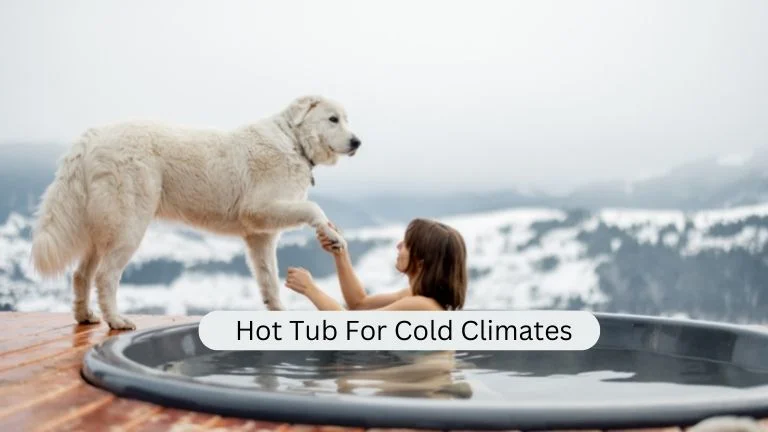
HOW TO CHOOSE THE BEST HOT TUB FOR COLD CLIMATES
Relax your body, rest better, relax, release stress, and spend time with your outstanding family members!
Relax in the comforts of your spa within the comforts at home. If you reside in a cold climate, the primary feature you’ll want from the hot tub is energy efficiency. Because the air surrounding it can be so hard, it has to work harder to keep its temperature warm, and it will cost more for it to run.
Types of Hot Tubs for Cold Climates
Inground Hot Tubs
- Installed in the ground for natural insulation
- Great for permanent setups
Above-Ground Hot Tubs
- Freestanding and movable
- Ideal for renters or frequent movers
Portable Hot Tubs
- Lightweight and easy to transport
- Good for vacations or temporary use
Hard-Side Hot Tubs
- Rigid shells (fiberglass, acrylic, or plastic)
- Durable and weather-resistant
Soft-Side Hot Tubs
- Flexible vinyl shells
- Affordable and easy to set up
Tip: Choose a hot tub designed for cold climates to ensure proper insulation and freeze protection.
HOW CAN YOU KEEP YOUR HOT TUB FROM FREEZING?
Don’t panic if you cannot get electricity due to an icy winter storm or downed electric lines! It will be warm for at least a day if it’s adequately constructed and insulated.
- Insulation: Choose a full-foam system for maximum efficiency.
- Efficiency: Check insulation type and plumbing layout.
- Cover: Use a solid, durable cover made by the hot tub manufacturer.
- Frame: Choose an ABS frame for cold climates, avoiding metal or wood to prevent rust and decay.
- Plumbing: Opt for a model with less plumbing for better heat retention (e.g., Bullfrog Spas).
- Vents: Choose adjustable vents to control heat escape depending on the season.
- Winter Temperature: Maintain water temperature between 38°C and 40°C (100°F – 104°F).
- Construction: Prioritize ABS frame over metal or wood for durability in cold climates.
- Thermal Blanket: Add an extra insulation layer with a thermal blanket placed under the cover.
- Freeze Protection: Ensure your freeze protection device is on (if equipped). Set a timer to circulate warm water through pipes every 15-20 minutes. Consider adding an extra freeze sensor.
- Jet Pressure: Lower jet pressure to minimize cold air intake and reduce heating demand.
- Personal Health Needs: Choose a hot tub with features benefiting specific health concerns (e.g., neck/back therapy).
- Frame Material: Choose an ABS frame for cold climates to prevent rust and rot.
- Base Pan: Install a base pan to reduce heat loss from frozen ground.
STAY WARM ALL WINTER LONG
It might be the perfect solution if you want to stay warm all winter long! Hot tubs are great for cold weather because they keep you nice and toasty. Plus, they’re a great way to relax after a long day.
When choosing it for cold weather, it’s essential to ensure you get one built for colder temperatures. Some hot tubs can only be used in warm weather, while others have unique features that help keep them warm in colder temperatures.
BEST HOT TUB COVERS FOR COLD CLIMATES
There are a few things to consider when choosing a hot tub cover for a cold climate.
- First, you want a well-insulated cover to keep the heat in.
- Second, you want a durable body that can withstand heavy snowfall.
- Third, you want a surface that is easy to use so you can take it on and off as needed.
Benefits of Having a Hot Tub Spa Cover
Having a hot tub spa cover is essential to maintaining the cleanliness, safety, and longevity of your hot tub. Here we get 5 benefits of having a hot tub spa cover:
- Energy Efficiency: A hot tub spa cover helps to keep the heat inside the hot tub, reducing the amount of energy required to keep it at the desired temperature. This means that you can save on your energy bill while also prolonging the lifespan of your hot tub.
- Improved Safety: A hot tub spa cover can help prevent accidents by keeping pets and children out of the hot tub. It can also protect against debris and other materials falling into the hot tub, reducing the risk of injury or damage to the hot tub.
- Increased Cleanliness: A hot tub spa cover helps to keep the hot tub water clean by preventing debris, dirt, and other materials from falling into the water. This reduces the need for frequent cleaning and maintenance.
- Protection from the Elements: A hot tub spa cover can help to protect your hot tub from damage caused by weather conditions such as snow, hail, or heavy rain. It can also prevent damage from UV rays, which can cause fading or cracking of the hot tub surface.
- Enhanced Comfort: A hot tub spa cover can help to maintain the temperature of the water, ensuring that it is comfortable and enjoyable to use. It can also provide added privacy and seclusion while using the hot tub.
How to Prepare and Maintain Your Hot Tub for Winter
Winter can turn a hot tub into a true sanctuary or an expensive headache if it’s not properly prepared. Cold air, ice, and snow test every part of your spa, so a few smart moves now can keep your tub running smoothly and your wallet intact.
Steps to winterize safely:
- Turn off power at the breaker.
- Drain all water from the tub, jets, and plumbing.
- Use a wet/dry vac to blow water out of lines.
- Remove filters and let them dry.
- Wipe the shell dry and leave the cover slightly ajar to prevent moisture buildup.
Common mistakes to avoid:
- Leaving even a small puddle in the pipes.
- Forgetting to disconnect or drain the pump and heater.
- Skipping power shutoff, which could risk damage if the system accidentally runs dry.
If you’re unsure, many professionals offer winterization services for around $200–$400.
Preventing Frozen Pipes
Frozen plumbing repairs can cost anywhere from $300 to $1,200, depending on the damage.
Keep your system safe by:
- Maintaining a steady water temperature (even if you’re not using the tub daily).
- Running the circulation pump 24/7 in freezing weather.
- Checking your tub after power outages.
- Installing freeze protection sensors that trigger heating when temps drop.
Ideal Water Temperature Settings in Subzero Weather
Most experts recommend dropping the temp by no more than 5–10 degrees if you’re away for more than a few days.
- Heaters work overtime to bring temps back up.
- Water is more prone to freezing if the power goes out.
- Shorter soak times mean you’re hopping out into the cold sooner!
Using Thermal Blankets and Wind Protection
These measures can trim 10–25% off your winter energy costs.
- Thermal floating blankets rest on the water’s surface to reduce evaporation and heat loss.
- Windbreaks—like privacy screens, fences, or even tall shrubs—shield your tub from icy gusts.
- Insulating mats or boards under the tub help block cold from the ground.
A good cover is essential, but adding a few extras can make a big difference:
Tips for Lowering Winter Energy Costs
Running a hot tub in winter doesn’t have to empty your wallet. Smart steps include:
- Keeping the cover tightly sealed whenever you’re not using the tub.
- Scheduling soak times instead of leaving jets on constantly.
- Upgrading to a high-efficiency pump and heater.
- Checking and maintaining insulation in your tub’s cabinet.
- Setting a reasonable water temp rather than maxing it out.
Energy Costs and Savings in Cold Climates
Over five years, those savings often surpass the upfront expense, making cold-climate features not just comfort upgrades, but smart financial decisions.
Average Monthly Cost of Running a Hot Tub in Winter
On average, running a hot tub year-round costs $20 to $50/month in mild climates. But in cold regions, that figure often climbs higher.
In freezing weather, expect:
| Climate Zone | Avg. Winter Monthly Cost | Possible High Cost |
|---|---|---|
| Mild (~40°F) | $20 – $40 | $50 |
| Cold (~20°F) | $50 – $80 | $100 |
| Extreme (<10°F) | $70 – $120 | $150+ |
Higher costs stem from longer heating cycles and greater heat loss in low temperatures.
Factors Driving Up Winter Costs
Several factors can send your winter hot tub bills soaring:
- Inefficient Insulation – Thin walls or a cheap cover can bleed heat fast.
- Frequent Lid Openings – Every time you remove the cover, heat escapes and the tub works overtime to reheat.
- Wind Exposure – Strong winds wick heat from both water and cabinet.
- Old or Undersized Heaters – Older systems may struggle to keep up in subzero temps.
- Low-Voltage Systems – Plug-and-play tubs on 110V circuits often run longer to reach and maintain high temps.
Even a few degrees of heat loss per hour can mean an extra $20–$40/month on your energy bill in winter.
Smart Upgrades to Save Money
Investing in certain features can significantly cut your winter costs. Consider:
- Full-Foam Insulation – Traps heat more effectively than perimeter systems.
- High-Quality Covers – A good cover can reduce heat loss by 25% or more.
- Thermal Floating Blankets – Float on the water’s surface to reduce evaporation and heat loss.
- Variable-Speed Pumps – Adjust flow rates to save energy during low-demand periods.
- Wi-Fi Smart Controls – Let you manage temperatures remotely and prevent wasteful heating.
These upgrades often pay for themselves over time, especially in harsh winter zones.
ROI on Investing in Cold-Climate Features
While premium insulation, efficient pumps, and sturdy covers may add $500 to $1,500 to the initial price of a hot tub, they usually return that investment in reduced energy bills.
For example:
- A high-quality cover alone might save $200–$400/year in energy costs.
- Full-foam insulation can cut winter electric bills by 20–30%, translating into savings of $30–$50/month in extreme cold.
TIPS FOR WINTER HOT TUBS
Have you realized that the most effective hot tubs need winterizing?
Winterizing should be optional if you plan to leave it empty for up to six consecutive weeks. The top-quality materials and energy-efficient design will prevent your pipes from freezing.
Why Cold Climates Demand Special Hot Tubs
A quote often shared in hot tub forums sums it up: “A cheap tub in winter is like an open window on your heater, it’ll drain your wallet faster than it warms your toes.”
How Cold Affects Hot Tub Performance
Cold air pulls heat away from a tub’s shell and plumbing, forcing heaters to work longer and harder. When the mercury drops below 20°F, heat loss can increase by over 25% compared to mild weather. That’s a heavy lift for any system and it’s often where cheaper tubs fall short.
- Water Temperature Fluctuations – A tub that feels perfectly warm at 7 PM might dip several degrees by midnight if insulation isn’t top-notch.
- Frozen Plumbing Risks – Pipes exposed to cold can freeze and crack, leading to repairs that often cost $300–$1,200.
- Longer Heat-Up Times – In extreme cold, heaters can take 50–70% longer to bring water to the desired temperature.
Energy Costs in Freezing Weather
Keeping a hot tub warm in sub-zero weather isn’t a cheap date. The national average for running a hot tub year-round hovers around $20–$50/month. But in a harsh winter climate, owners have reported costs spiking to $70–$120/month if their spa isn’t properly insulated.
Here’s a quick look at typical winter costs:
| Climate Zone | Avg. Monthly Cost | Possible High Cost |
|---|---|---|
| Mild Winter (~40°F avg) | $20 – $40 | $50 |
| Cold Winter (~20°F avg) | $50 – $80 | $100 |
| Extreme Cold (<10°F) | $70 – $120 | $150+ |
Higher costs stem from:
- Continuous heater operation to combat freezing air
- Heat escaping through thin covers or poor cabinet insulation
- Inefficient pumps running longer cycles to maintain temperature
Heat Retention Challenges
Heat retention is where cold-weather tubs either shine or stumble. A sturdy, insulated shell and an airtight cover keep precious warmth where it belongs—inside your tub. Without those defenses, heat can vanish in no time.
Think of your hot tub like a thermos: the better it’s sealed and insulated, the less heat it loses. Factors influencing heat retention include:
- Type of Insulation – Full-foam designs are prized for blocking heat loss, while partial-foam or perimeter systems can leave gaps.
- Cover Quality – Cheap vinyl covers leak heat fast. A thick, tight-fitting cover saves $20–$50/month in energy.
- Cabinet Seals – Gaps in cabinetry allow cold air to circulate and rob the tub of warmth.
Common Problems Owners Face in Winter
Plenty of folks learn the hard way that not every hot tub is cut out for winter’s chill. Here’s what often goes wrong once snow starts falling:
- Skyrocketing Electric Bills – Owners are shocked when winter power costs double or triple.
- Frozen Equipment – Power outages can spell disaster if water freezes inside pumps and pipes.
- Shell Cracks or Damage – Rapid temperature changes stress cheaper materials.
- Slow Recovery Times – After opening the cover, some tubs struggle to regain heat quickly enough to keep soaking comfortable.
User Reviews & Real-World Experiences
User reviews shine a light on what works and what doesn’t when temperatures plunge.
Insights from Reddit Users
Reddit is full of hot tub owners swapping stories about wintertime soaks. Here’s what bubbles to the top:
- Heat Retention Wins Praise: Owners rave about full-foam insulated tubs, saying they “barely lose a degree or two” overnight in single-digit temps.
- Cover Quality is Crucial: Many note that a cheap cover is “like leaving your front door open in a snowstorm.”
- Plug-and-Play Divide: Some users report plug-and-play tubs struggle to stay hot during longer soaks, while others manage fine with added insulation and windbreaks.
One Redditor summed it up: “Invest in insulation upfront. It’s the difference between relaxing in winter and throwing money at the power company.”
Common Complaints in Freezing Temperatures
Even the best tubs face challenges when the weather gets fierce. Common gripes include:
- Skyrocketing Energy Bills – Owners in cold climates often see winter power costs double or triple, especially with poorly insulated tubs.
- Slow Heat Recovery – Some tubs drop several degrees during a soak and take hours to rebound.
- Frozen Components – Power outages in deep cold can freeze pumps and pipes fast, leading to expensive repairs.
- Cover Strain – Heavy snow loads can warp or crack cheaper covers.
Owners often say the biggest regret isn’t buying a tub—but buying one not built for winter.
Success Stories and Brand Loyalty
Plenty of users also share glowing experiences. Those who chose well-insulated models often report:
- Stable Water Temps – Even in subzero nights, water stays toasty.
- Reasonable Energy Costs – With full-foam insulation and quality covers, many users keep winter bills between $50–$80/month.
- Enjoyment All Season – Snow falling while steam rises is a highlight of winter ownership.
Brands frequently earning loyalty in cold climates include Arctic Spas, Bullfrog Spas, and Beachcomber. Owners describe these tubs as “built like tanks” and worth the extra money.
One user shared: “My Arctic Spa runs flawlessly through -20°F winters. I’d buy it again in a heartbeat.”

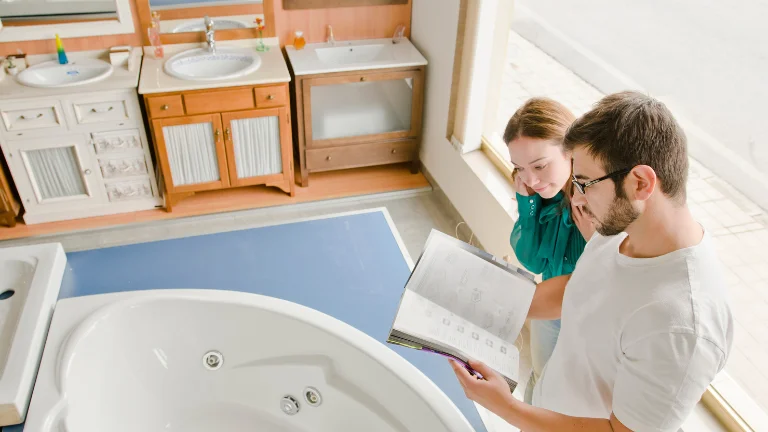








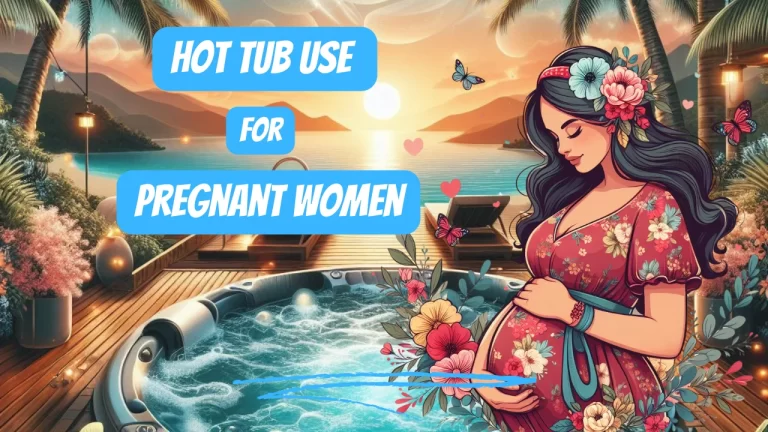
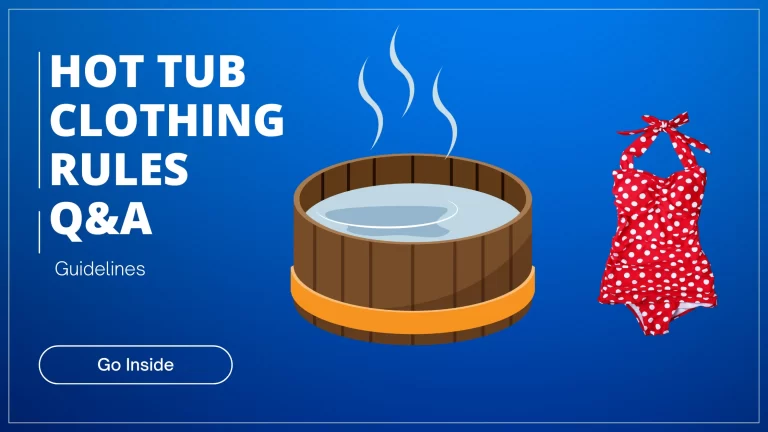
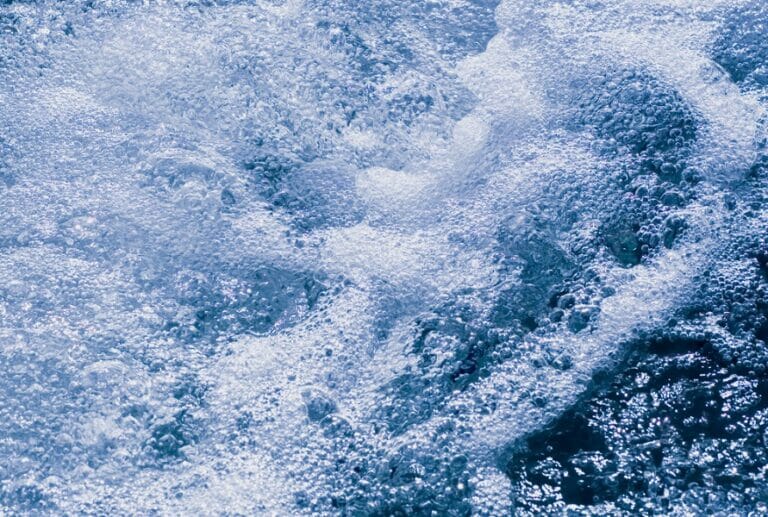

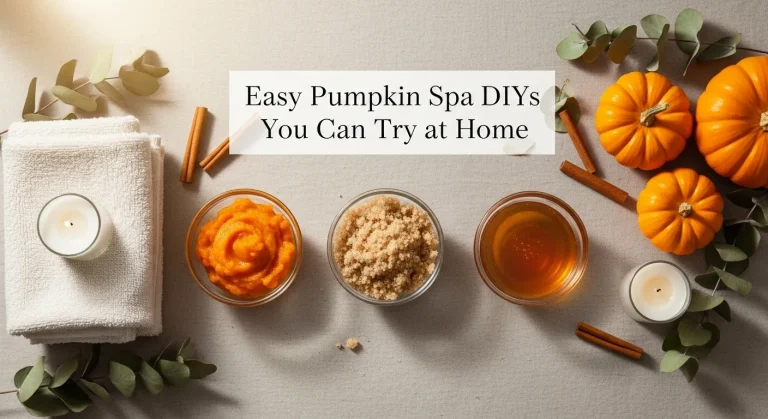
7 Comments